Formulating Feed Diets to Improve Nutrient Uptake, Reduce Environmental Footprint
By: Paul Davis, Ph.D., director of quality, animal food safety and education, American Feed Industry Association
I recently had the privilege of presenting to the U.S. Department
of Agriculture’s 98
th annual Agricultural Outlook Forum on the ways
the feed industry is working toward reducing greenhouse gas emissions on farms.
Being the son of a career USDA veterinary medical officer, a fifth-generation
farmer and the first person from the
American
Feed Industry Association invited to present at the forum, this opportunity
was indeed special. It gave me the opportunity to share how established animal
nutrition concepts, as well as new feed technologies, could be part of the path
to less environmental impacts from animal agriculture, if certain regulatory
roadblocks are cleared.
As I gathered my thoughts for this presentation, I reflected
on my former animal nutrition professors’ and mentors’ advice: do not discard established
concepts in favor of flashier, yet unproven strategies. The feed industry is
and will continue to be sustainable in several manners.
First, let’s look at some established concepts in animal
nutrition. The ingredients that are included in a feed diet (or “ration” as we
call it in the industry), how they are combined with respect to the amounts,
proportions and ratios, how they are presented to the animals and how they may
be enhanced with technologies, both established and novel, can increase animals’
nutrient utilization and thus decrease environmental impact.
Put simply, we endeavor for
more of the feed ration to be ingested, digested and metabolized by the animal to
turn into nutritious foods that people can eat.
When formulating a ration, we choose ingredients often from
the creation of a primary product or process outside of the animal agriculture
industry (e.g., dried distillers grains), otherwise known as coproducts, which can
improve nutrient utilization. In doing so, we can divert materials destined for
landfills and “upcycle” them into animal feeds, using more of what was grown or
mined for food production, increasing efficiency and decreasing environmental
impact.
Likewise, when ingredients with higher bioavailability are
selected (e.g., selenomethionine), more of the nutrients can be utilized by the
animal, lowering nutrient excretion. In some instances, animal food nutritionists
and formulators can choose ingredients based on content of a specific nutrient
into a specific application, an example being high-lysine corn included in a
growing swine diet. Targeted inclusions such as these increase the utilization
and decrease nutrient loss due to ‘over formulation.’
Further, the ways and means in which the chosen ingredients
are processed and combined affect their utilization and efficiency, something
which, at first blush, seems simple, such as particle size, but has a great
impact on digestibility. Adhering to optimum particle sizes for ingredients for
each species and livestock class can greatly reduce nutrient waste. In
addition, some nutrients, minerals in particular, can have an antagonistic or
binding effect on each other. Responsible, sustainable formulation accounts for
these and helps ensure that antagonisms are not inherently created. I have
known of feed formulations that contained molybdenum (included to help prevent
copper toxicity in sheep) and added copper. This combination pretty well
assures that the added copper will be excreted into the environment as a copper-thiomolybdate,
something in which animal nutritionists are cognizant.
Once a ration has been formulated and compounded, its
delivery and presentation to the animal also has bearing on its final efficiency
of use. Nutrients from feed that are wasted prior to ingestion have no chance
of being utilized; likened to spilling gasoline on the ground as you try to
fill your vehicle’s fuel tank. Great care is taken to ensure on-farm feeders are
adjusted properly to ensure proper feed flow, minimize waste and allow for the
optimum height. Likewise, there should be adequate feeder space when
self-feeding animals, and feeding frequency and amounts should allow for
optimum production. It truly takes a village in animal agriculture!
Finally, the U.S. feed industry is blessed with a wide
variety of feed additives that help improve nutrient utilization and production
efficiency. We often take their safety and efficacy for granted. As part of
being a good steward of feed resources, feed additives should be included in
rations where appropriate. There are
instances of up to 10% efficiency being gained from the inclusion of one feed
additive, and while there is no guarantee of a cumulative effect, at times,
using multiple feed additives pays dividends. Even with the advances that we
have enjoyed, it seems feed additives remain a new frontier.
We have many talented nutritionists, veterinarians and other
scientists across the U.S. working tirelessly to discover or create new
efficacious feed additives to improve production and/or reduce enteric methane
emissions in livestock. However, their efforts seem to reach a regulatory
bottleneck in the Food and Drug Administration’s approval process and are
further hampered by the inability to make label
claims regarding production, except in the realm of medicated feed
additives, which are regulated as drugs. Other countries, such as Brazil and
some across Europe, have embraced these feed additives with environmental
benefits, putting U.S. farmers and ranchers at a disadvantage globally.
In order to advance animal agriculture and continue to
produce meat, milk and eggs more efficiently and sustainably, the industry
desperately needs more expedient approvals of feed ingredients and a broader
pathway for label claims. Imagine what the next great feed additive could do
for improving production and reducing environmental impact.












